пятница, 10 ноября 2023 г.
воскресенье, 22 октября 2023 г.
среда, 18 октября 2023 г.
понедельник, 16 октября 2023 г.
четверг, 12 октября 2023 г.
четверг, 5 октября 2023 г.
среда, 4 октября 2023 г.
вторник, 3 октября 2023 г.
понедельник, 25 сентября 2023 г.
пятница, 22 сентября 2023 г.
вторник, 19 сентября 2023 г.
четверг, 14 сентября 2023 г.
среда, 13 сентября 2023 г.
понедельник, 11 сентября 2023 г.
четверг, 7 сентября 2023 г.
понедельник, 4 сентября 2023 г.
пятница, 1 сентября 2023 г.
четверг, 31 августа 2023 г.
среда, 30 августа 2023 г.
понедельник, 28 августа 2023 г.
воскресенье, 27 августа 2023 г.
суббота, 26 августа 2023 г.
пятница, 25 августа 2023 г.
четверг, 24 августа 2023 г.
вторник, 22 августа 2023 г.
понедельник, 21 августа 2023 г.
воскресенье, 20 августа 2023 г.
суббота, 19 августа 2023 г.
пятница, 18 августа 2023 г.
четверг, 17 августа 2023 г.
среда, 16 августа 2023 г.
вторник, 15 августа 2023 г.
понедельник, 14 августа 2023 г.
воскресенье, 13 августа 2023 г.
суббота, 12 августа 2023 г.
пятница, 11 августа 2023 г.
четверг, 10 августа 2023 г.
среда, 9 августа 2023 г.
вторник, 8 августа 2023 г.
понедельник, 7 августа 2023 г.
воскресенье, 6 августа 2023 г.
суббота, 5 августа 2023 г.
пятница, 4 августа 2023 г.
четверг, 3 августа 2023 г.
среда, 2 августа 2023 г.
вторник, 1 августа 2023 г.
понедельник, 31 июля 2023 г.
воскресенье, 30 июля 2023 г.
суббота, 29 июля 2023 г.
пятница, 28 июля 2023 г.
CLUBBEST-50-LIGHT - open project
CLUBBEST-50-LIGHT
Brief description of the project.
CLUBBEST 50 LIGHT is an open project built using RTMV-technology. In this project, you will discover a new way of visualizing music in real time. All you need to do is to beep and enjoy the visualization.
RTMV-technology is a new understanding in building intelligent music visualization systems. RTMV-technology is a set of rules and algorithms for creating stand-alone music visualization devices.
CLUBBEST 50 LIGHT is the most simplified version of the music visualizer that allows anyone to repeat it on their own.
CLUBBEST 50 LIGHT - consists of the visualizer itself built on the MCU PIC24FJ256GA702. As an output optical device, you can use pieces of LED strips assembled on LEDs of the WS2812 type with a quantity of 50 pcs. That is, any type of LEDs compatible with the data transfer protocol adopted in WS2812 LEDs will do.
To connect the tapes on the board, the board has two TYPE-C connectors that allow you to supply data and power.
Description of the circuitry of the music visualizer.
Structurally, the design is as follows.

Audio input.
The audio signal is fed through the connector to the audio module.
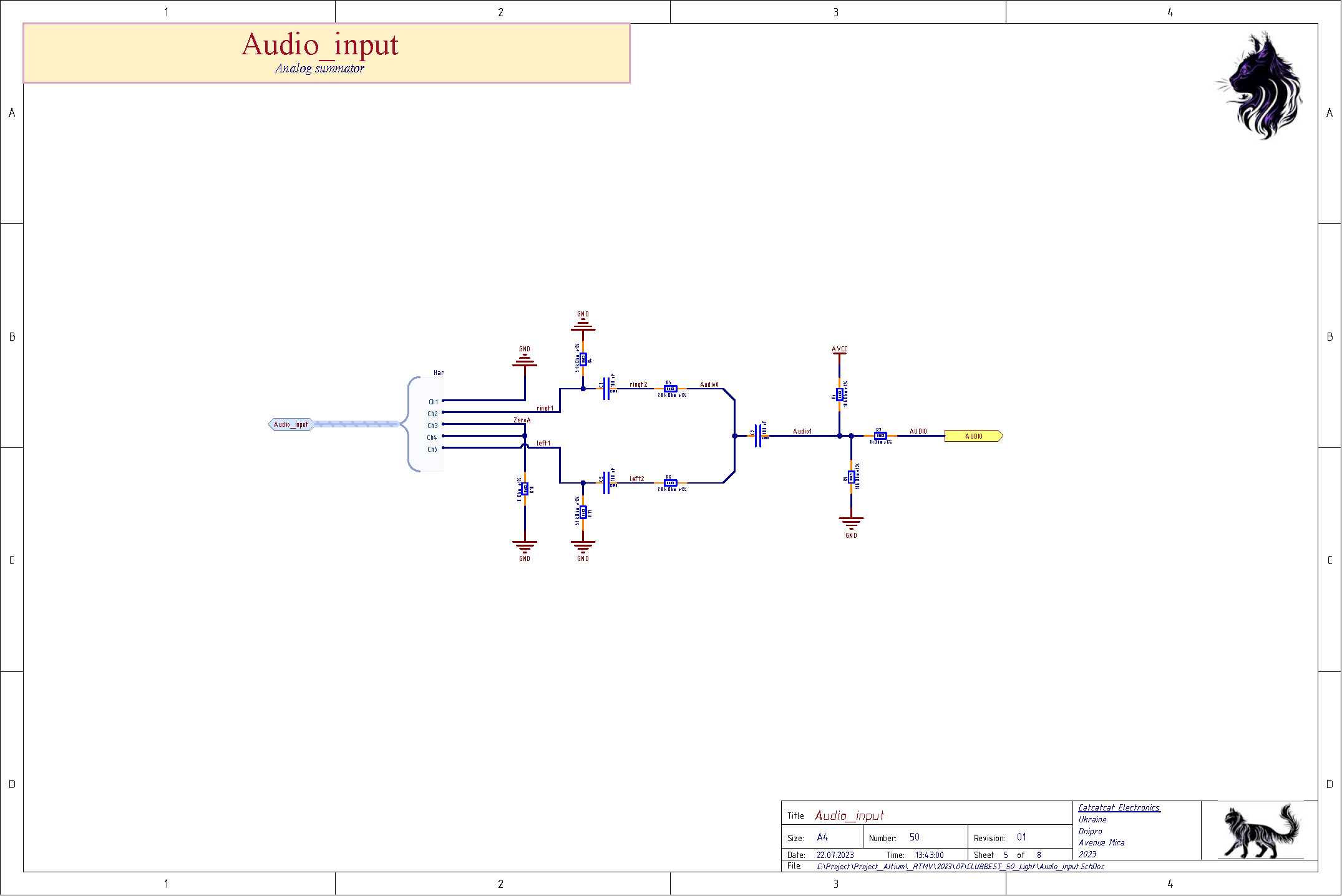
The audio module sums the left and right channels and performs the zero balancing of the audio signal. All components must have a tolerance of 1%, especially for resistors R6 and R9. After the audio module, the converted data is sent to the MCU.
MCU.
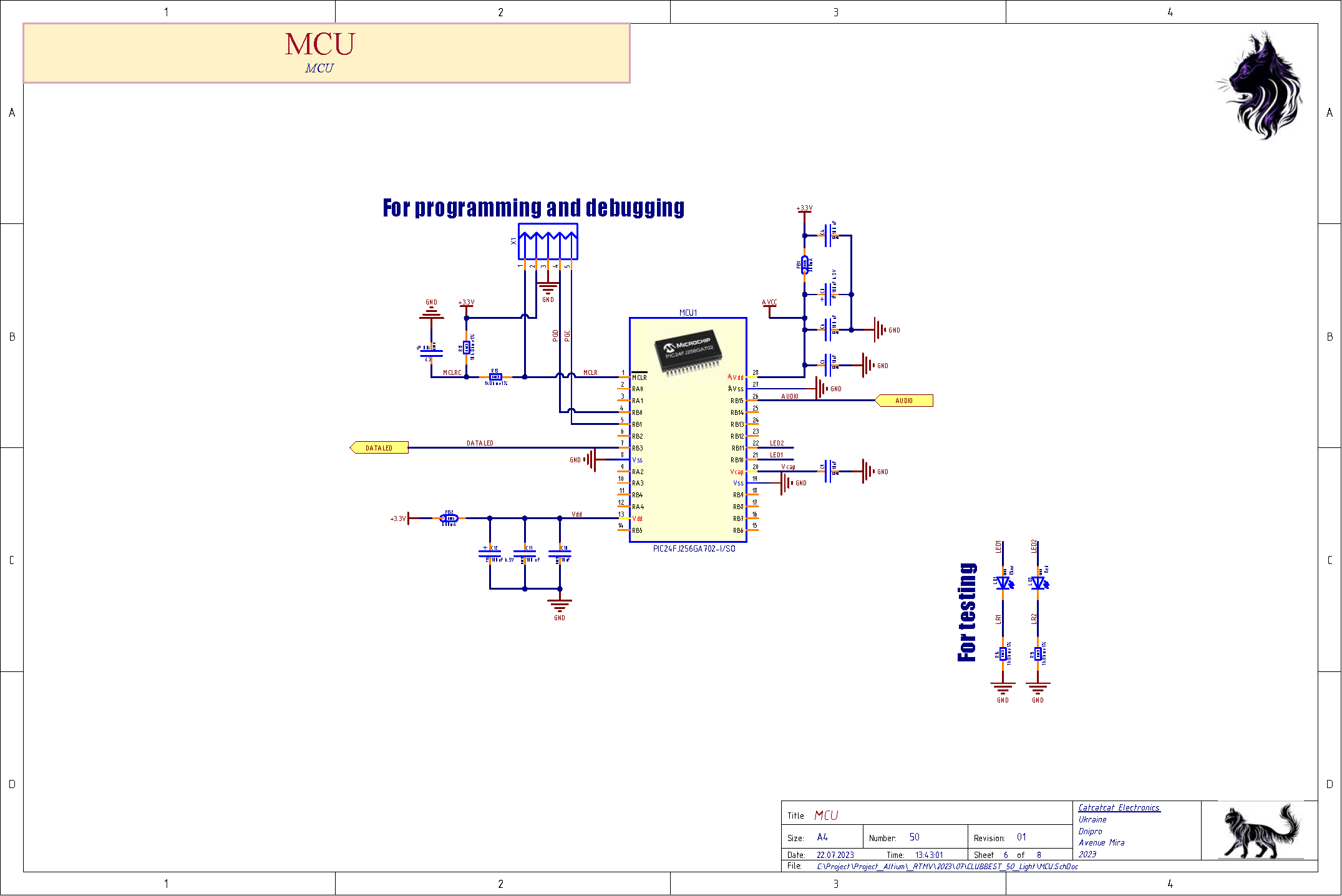
The MCU performs a complete conversion of an audio analog signal into digital data for visualization on the same type of light sources according to the rules of RTMV - technology. Scheme MCU fellow so that allows you to program the MCU directly into the finished device. During the build process, you will need to flash the firmware yourself (or possibly purchase a pre-programmed MCU).
Digital visualization data is sent to the signal level matching module. It is designed to match the logic levels of 3.3 volts that the MCU works with the logic levels of the signals that the LEDs work with.
Digital output.
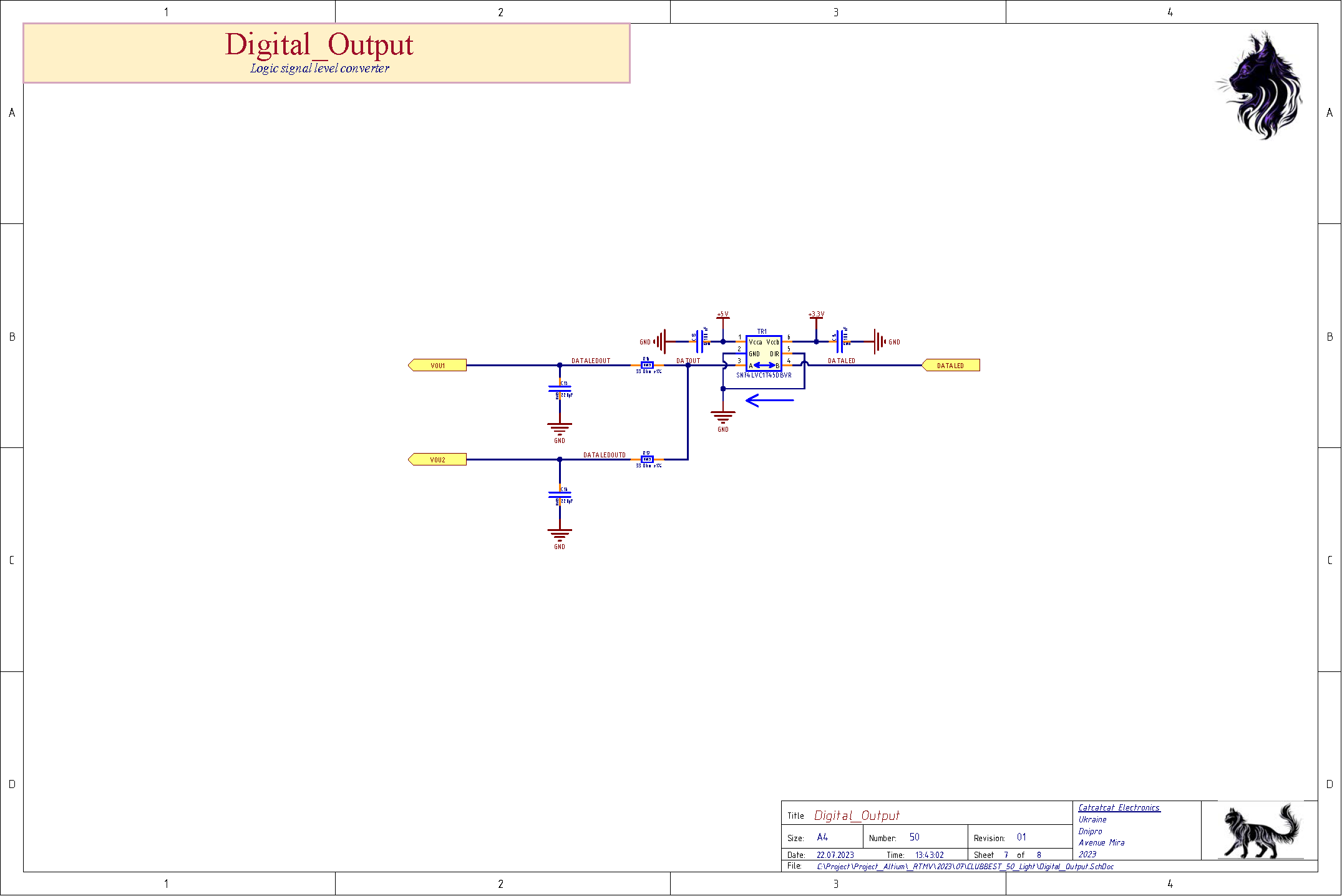
At the output, filters are installed to reduce the signal slew rate and are designed to suppress signal reflection, which can be caused by wires connecting the LED strips to the visualization module.
CLUBBEST 50 LIGHT is powered by a stabilized 5-volt power supply. The easiest way is to use a 5V 2.4A mobile phone power adapter with a USB2 connector, and use a USB2-TYPE-C cable for power.
MCU power circuit.
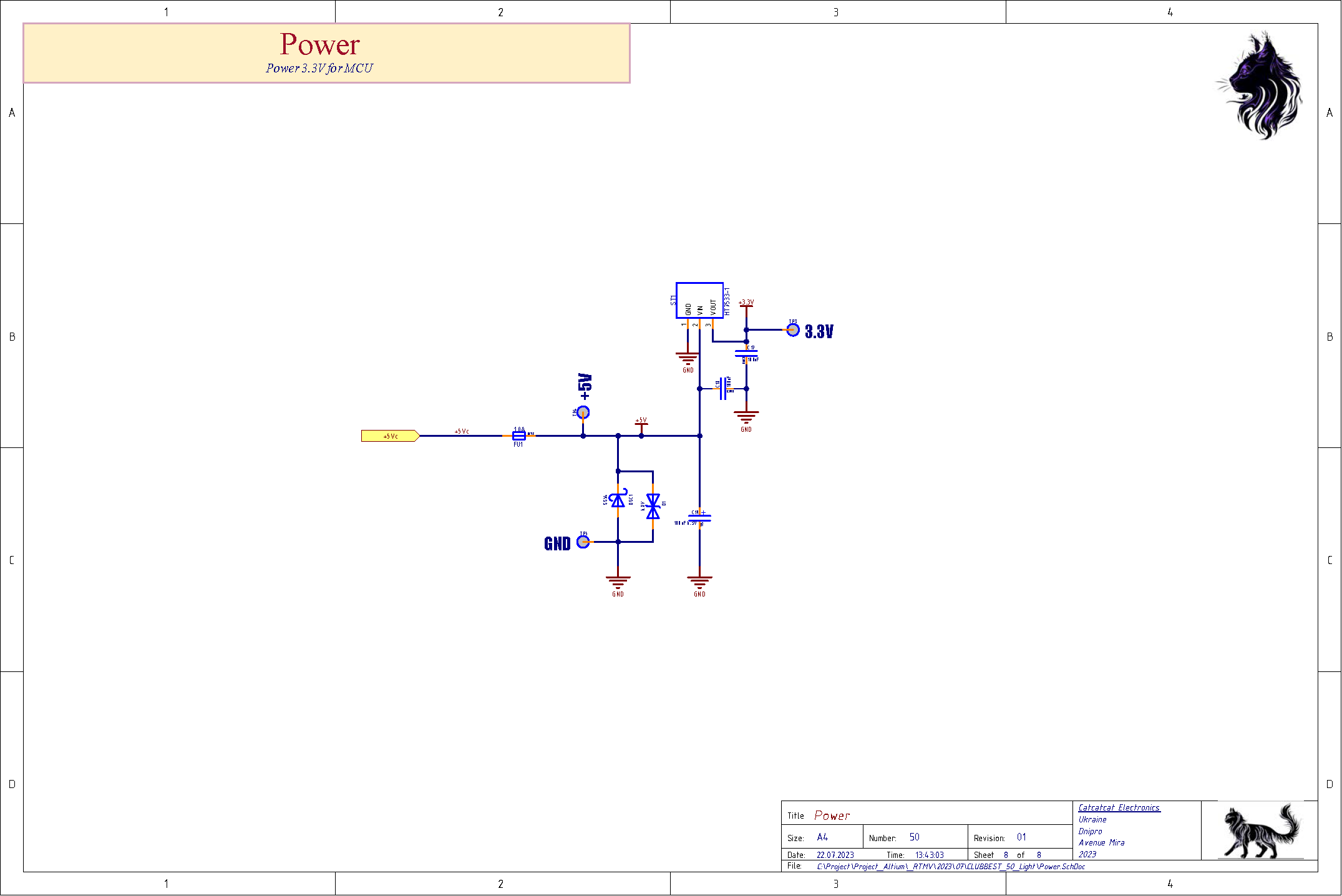
The power supply is a LDO regulator from 5.0 to 3.3 volts to power the MCU. Additionally, reverse polarity protection is built into the device.
Please note that the built-in protection only protects the visualizer itself; it does not protect the connected ribbons, so be careful during installation and when you turn it on for the first time with connected ribbons with LEDs. Be sure to check the polarity of the connection of the ribbons and the power supply.
When assembled, the visualizer will look like this:
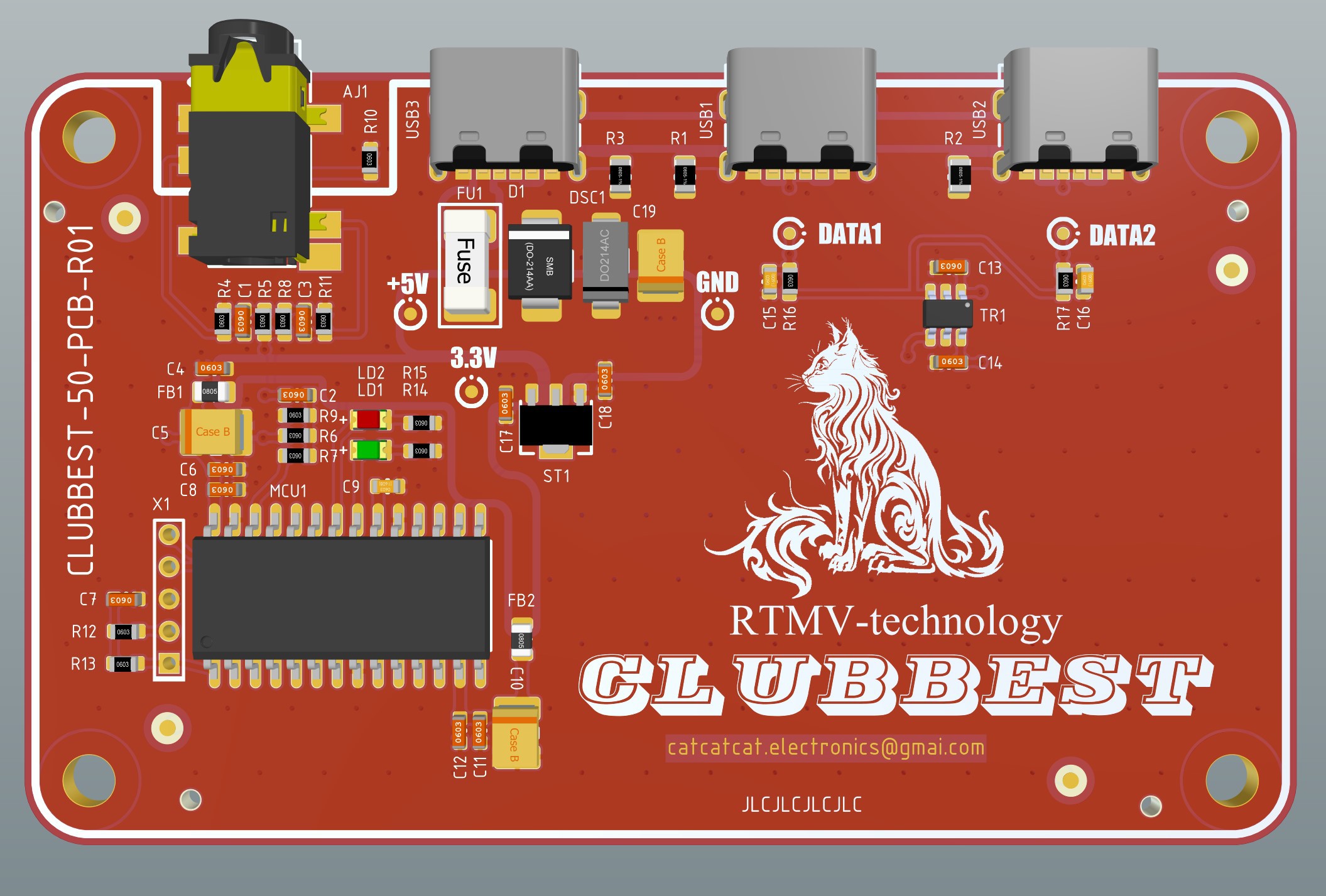
USB 3 connector is for power supply. USB 1, USB 2 - for connecting ribbons. AJ1 - for giving an analog sound signal.
Assembly of the device.
The assembly of the device can be done entirely by hand. But I recommend doing some assembly at the JLCPSB factory. Why partially? At the factory, the assembly is, everything except the MCU. MCU will have to be purchased separately and soldered by yourself. Programming of the controller can be done directly on the board; the X1 connector holes are provided for this. The signal layout is compatible with MPLAB ® PICkit ™ 4/5 or MPLAB ® ICD 5 In - Circuit Debugger/Programmer.
List of components for self-assembly:
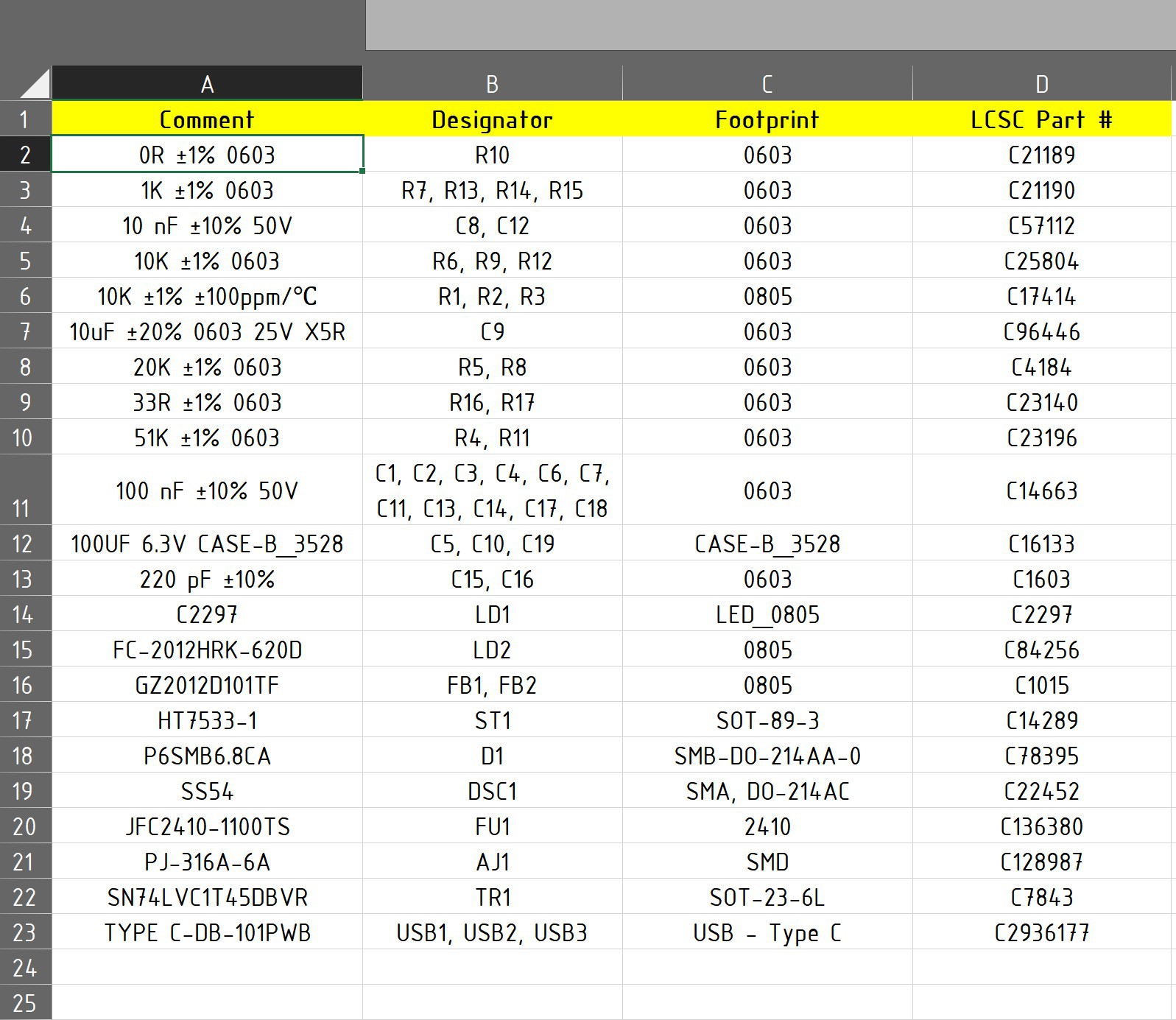
Note LCSC Part # - these are the component codes on the JLCPCB or in the store https://www.lcsc.com/ .
Additionally, you need to purchase the PIC24FJ256GA702-I/SO from any supplier.
link to original article, use google translate https://catcatcat.d-lan.dp.ua/clubbest-50-light/
Downloads:
Scheme in PDF format - GD CLUBBEST-50-PCB-R01.PDF.
https://catcatcat.d-lan.dp.ua/download/clubbest-50-light-scheme-in-pdf-format/
BOM sheet in Microsoft format Excel - CLUBBEST-50-PCB_BOM-R01.xlsx for automatic PCB assembly.
https://catcatcat.d-lan.dp.ua/download/clubbest-50-light-bom-sheet-in-microsoft-format-excel/
Pick Place sheet in Microsoft format Excel - CLUBBEST-50-PCB_PPl-R01.xlsx for automatic PCB assembly.
https://catcatcat.d-lan.dp.ua/download/clubbest-50-light-pick-place-sheet-in-microsoft-format-excel/
Archive with a complete set of files for PCB manufacturing - CLUBBEST-50-PCB-R01.rar.
https://catcatcat.d-lan.dp.ua/download/clubbest-50-light-archive-with-a-complete-set-of-files-for-pcb-manufacturing/
Firmware - CLUBBEST_50_Light.X.production.hex.
https://catcatcat.d-lan.dp.ua/download/clubbest-50-light-firmware/
Description for manual assembly of the project - MAD CLUBBEST-50-PCB-R01.PDF.
https://catcatcat.d-lan.dp.ua/download/clubbest-50-light-description-for-manual-assembly-of-the-project/
четверг, 27 июля 2023 г.
среда, 26 июля 2023 г.
вторник, 25 июля 2023 г.
понедельник, 24 июля 2023 г.
воскресенье, 23 июля 2023 г.
четверг, 20 июля 2023 г.
среда, 19 июля 2023 г.
вторник, 18 июля 2023 г.
понедельник, 17 июля 2023 г.
воскресенье, 16 июля 2023 г.
суббота, 15 июля 2023 г.
пятница, 14 июля 2023 г.
четверг, 13 июля 2023 г.
среда, 12 июля 2023 г.
вторник, 11 июля 2023 г.
воскресенье, 9 июля 2023 г.
пятница, 7 июля 2023 г.
четверг, 6 июля 2023 г.
среда, 5 июля 2023 г.
вторник, 4 июля 2023 г.
воскресенье, 2 июля 2023 г.
The art of DJ.
The art of DJ.
The art of DJ, has become
widespread. Today, a DJ is not just a person whose task is to mix tracks, a DJ
at present is already a composer who creates new music. The art of a DJ lies in
a live set, where the main task of mixing tracks is also arranging music,
adding musical fragments and sound effects in real time. The art of a DJ is,
first of all, direct communication with the listener through live music.
Light accompaniment of sets has
become an integral part of the life of a DJ. No one will argue with me that the
light accompaniment of music will create an additional atmosphere and enhance
the perception of a piece of music. The light accompaniment of music can even
radically change the perception of the musical work itself. But there is also
the other side of the coin, if the light is not synchronized, if it does not
correspond to the piece of music, the light can play a negative effect.
Therefore, a feature of the use of light accompaniment in a piece of music is
the presence of an inextricable link between music and light.
Many lighting equipment manufacturers have begun to produce lighting consoles for mobile DJs, on the basis of which they can control their lighting devices. All these remotes are built on the same principle, you need to write a control sequence for your lighting fixtures and save this control program first. And during the set, run the visualization program for your show. To get the most out of music visualization, you need to create a separate lighting composition for each track. Audio functions allow one way or another to synchronize the lighting program with the music track. Additionally, during the operation of the light console, you can manually switch settings and control additional devices, such as a smoke generator, stroboscope.
But this approach has significant drawbacks:
1. DJs have to constantly come up with
new light sequences to control lights, because the same sequence annoys the
viewer even when the music track is played repeatedly.
2. A unique lighting control sequence
written for a specific music track, not suitable for another piece of music.
3. Such lighting consoles are
completely ineffective for live music, a DJ is a creative person, during a
performance, a DJ must focus on music, and a modern approach with such consoles
distracts the DJ's attention from the main task. Therefore, in the DJ
broadcasts that have gained popularity now, most often there is no light
accompaniment.
4. The absence of a real connection
between the formed light images and the musical flow. Synchronization mechanisms
are imperfect and most often simply do not work.
Manufacturers of modern lighting
consoles for mobile DJs have mainly focused on creating compact modern designs
in a new style, these are backlit buttons, encoders, the presence of a graphic
display and nothing more. There really are no revolutionary innovations in
these consoles, only one desire of the manufacturer can be traced, to present
the already existing principles of visualization differently and shove them
into a new package.
I think that a DJ needs lighting
equipment that is intelligent, able to create music visualizations as
independently as possible, in real time. Such equipment that will allow the DJ
to fully concentrate on the music. A feature of such a system should be a
visible connection between visual images and a piece of music. The ideal option
is when the music itself creates a light show.
I have talked a lot with the
so-called lighting technicians whose job is to create light shows at concerts,
and they convince me that the creation of such devices is impossible, and that
this is a creative process that electronics cannot. Talented lighting
technicians are artists in their field and create amazing light shows, but even
so, this show is only for one time. Moreover, I have never seen, let's say, a
"good" synchronization of light and music anywhere, which is
sometimes very upsetting. But most often such light shows look like a
combination of so-called lighting effects, running lights, strobe lights,
everything is mixed in the hope that somewhere, something, somehow will fall in
time with the music and it will be good.
For a DJ who uses live music in his
work, using a pre-programmed composition approach is not practical, and hiring
a lighting engineer is simply unrealistic. Therefore, we often see that most
often the light used in a DJ performance has nothing to do with the music.
Mankind has long noticed that music
has the ability to excite visual images in the human mind, and therefore light
shows have become an integral part of any musical concerts and performances.
I have devoted all my free time to a
hobby, which is to develop real-time music visualization systems. From the
beginning, I built many devices according to ready-made schemes, created output
optical devices, to the best of my financial capabilities. But the result of
these works always led to the same result, that the newly built device, which
in the first days pleases with a variety of effects, after a couple of days no
longer pleased, and after a couple of weeks, interest in it simply disappeared.
This effect is called the visual fatigue effect. This is due to the fact that
the human brain visually remembers a lot of information and requires its
constant updating.
I concluded for myself that the
existing approach to building automatic devices, which allows real-time
visualization of music, does not correspond to reality. We need new rules,
theory and technological principles that would allow us to take a fresh look at
the visualization of music, according to which it would be possible to create
devices capable of performing automatic visualization of music in real time,
without human intervention. Moreover, I want to say that such devices should
have such algorithms that would allow creating a visual arrangement of a melody
that, when playing the same piece of music, would create a new visualization
that would eliminate the effect of visual fatigue.
I'm not a musician, I just love
listening to music, but I'm a fan of music visualization. Therefore, I went
down the path, at the beginning of which I determined for myself the basic
principles of what visualization of music represents for me. I called these
principles - real-time music visualization technology or abbreviated RTMV-technology.
Basic principles.
1. In any piece of music there are two
components - this is melody and rhythm.
2. The melody is a smooth component,
which is like a wave that runs like a thread through the entire piece of music.
3. Rhythm - or you can call it a
pattern, it can include a solo instrument, the performer's voice, well, the
rhythm itself is something opposite to a melody, a dynamic component of a piece
of music.
4. The visualization algorithm must
perform the “light arrangement” of a piece of music. What does it mean? He must
create a new visualization, each time for the same piece of music. The
visualization algorithm must be intelligent to some extent.
5. Output optical device (OOD) - this
can be a screen, it can be a set of various light sources that have a certain
location in space, both among themselves and relative to the viewer.
6. Symmetry principle. This is the
principle of beauty. I came to this when creating output optical devices or a
principle for arranging lighting fixtures on a stage. If the formed light
images are symmetrical, it is always perceived as beautiful. And if you look at
all the light installations, then 100 percent you will see that the principle
of symmetry is present everywhere.
7. The algorithm of work, music
visualization systems, must be completely autonomous. Algorithms must
independently determine the style of a piece of music and, depending on this,
create control sequences for controlling lighting devices.
8. The frequency component analysis
mechanism must distinguish one note from another.
9. The main requirement of RTMV-technology
is the principle of creating light images. Light images must have a visible
connection with the piece of music, which means that the visualization must be
connected and synchronized with the music. Or to put it differently - the
visualization should be created by the music itself. Each light image created
by RTMV-technology must be derived from the melody and rhythm of a piece of
music.
Taking these principles as a basis,
I began to develop algorithms and design controllers. When designing such
devices, the format of the digital data needed to render the music is
determined by the light sources used in the light show. For me, the most
affordable light sources were LEDs. And with the advent of LEDs with built-in
drivers, they have become the main means of visualization. This does not mean
that RTMV-technology cannot be used with modern stage devices, it means that it
will require a description of additional control functions for a particular
lighting fixture or group and nothing more.
At the beginning, to visualize
music, it was supposed to use a 2D screen, and RTMV-technology itself was
developed for this type of screen. When the development process reaches a
certain level, it is necessary to create a working prototype so that the idea
can be shown for objective feedback. Getting feedback is an important step, as
it allows you to take a fresh look at the results of your work and provides an
opportunity to go beyond your subjective understanding of reality. But it
turned out that creating a prototype of the 2D version required significant
financial resources that I could not allocate from my income. And without
showing a working device, it is not possible to find an interested sponsor or
manufacturer of lighting equipment.
Then I decided to move away from the
chosen direction and create a series of music visualization devices, such as a
sound signal level indicator (VU-meter), so that I could earn the necessary
start-up capital on them. But all the solutions that I created did not suit me,
I tried to add more lighting effects, but everything ended in the same
obsessive - fatigue effect. That is, a certain period of time passed and the
device simply got bored, became uninteresting and unattractive. And this is
fundamentally contrary to the purpose of my work. Then I decide to apply, a
simplified version of RTMV-technology, for a linear type display. A linear
display is an arrangement of the same type of light sources on one straight
line and this option is called - 1D visualization. The first test results made
me very happy. The fact is that at the very beginning of the creation of RTMV-technology,
I rejected the concept - 1D visualization, since I believed that it was
impossible to create sufficiently effective light images in such a design. But
as the result of the experiment showed, this is possible and at a fairly
effective level.
This project was named - CLUBBEST. Two
types of visualizer prototypes were developed and manufactured, models M68 and
M100. They differ in the type of LEDs
used, their number and approach to the data visualization mechanism. The main
purpose of these models is for home use, I personally oriented these projects
as a decorative device for listening to music on my PC. But as the reviews
showed, this visualization approach also interested music professionals. To
popularize this, I started to record live videos of these devices in order to
get more information about the perception of this new art form. And I started
getting positive feedback. The most inspiring feedback for me was when a
subscriber of my YouTube channel wrote - "I felt like I saw the
music". Yes, and it's true, I'm developing this technology so that a
person can see the music.
Pay attention to how well-known
brands of lighting equipment manufacturers are suitable for demonstrating new
technologies or new visualization systems. They make advertisements and create
promo videos in one interesting way. In their videos, they talk a lot and in
detail, and sometimes even tediously, about the new device, about its unique properties
and capabilities, how many new connectors it has, how many beautiful buttons,
what convenient encoders, and now they have also added an OLED display. How
much can be programmed into this new device of light control sequences, hiding
how many additional hours of work it will take. And most often there are no
examples of a real video demonstration of the operation of such a device, with
lighting devices, or a demonstration of a maximum of 10 seconds. And why is it
so? This is because there is simply nothing to watch for more than 10 seconds,
because nothing really new has been invented in this device. And for some
reason, everyone is silent about the fact that the use of such an approach to
visualization leads to the well-known effect of visual fatigue.
I think it's important for a DJ to
know, especially for a mobile DJ, how comfortable, efficient and easy the new
equipment you buy will be. To what extent the use of this equipment will
simplify his life with lighting devices and will not distract him from his main
work on music. Moreover, now this new device will help him in his musical
creativity. A DJ, having created a piece of music, should be able to
immediately see its visualization in real time. And such modern technologies
offered by modern brands do not allow him to do this.
To evaluate the work of the new
visualization technology, to show its objectivity, I shoot commercials,
recording the entire piece of music. Please note that I do not edit the video,
leaving only some good moment. In order to provide information about the real
work of the music rendering mechanism, I try to show the result of music
rendering throughout the entire piece of music, to show the connection of light
with music. And even if it's a broadcast, I try to show a section of the video
lasting 5-10 minutes so that you can evaluate how effective the DJ's
performance will be if visualization is also added to his work. I record
visualizations with different musical styles so that you can see how the
technology deals with the processing of this or that information. Music should
be listened to, and visualization should be viewed. The visualization should be
of such a level that there is a feeling that the sound does not come from the
speakers, but the sound comes from the light.
CLUBBEST is built on the principle
of Plug and Play. All you have to do is apply an audio signal to the input, and
RTMV-technology will do the rest. CLUBBEST does not have any tuning knobs. CLUBBEST
itself determines the style of a piece of music and generates visual effects
synchronously with the piece of music on the output optical device available to
it in the current configuration. In the CLUBBEST project, everything is
simplified, the light sources always have the same characteristics, their
number is constant, so the algorithm is simplified, and it is focused only on a
given configuration of the output optical device.
Please note that CLUBBEST is the
most simplified version of RTMV-technology, but already built prototypes can be
used as a basis for creating a number of serial products for mobile DJs, as
well as for consumers, for individual use, when listening to music.
And I want to add that there is
another wide application for such systems that use real-time music
visualization - these are various clubs, cafes, bars, restaurants where there
is music and the owner of the establishment wants to add live light to attract
attention. visitors.
If approached from the standpoint of
using RTMV-technology stage lighting control, then the lighting console created
on its basis will have one main feature that distinguishes it from modern
consoles - it will not have a tedious control sequence programming mechanism
for lighting fixtures. RTMV-technology is a technology whose essence lies in
the fact that the music itself must create light visualization.
The pre-setting of such a lighting
console may include a visual description of which lighting fixtures you have to
work with and how these fixtures are located in space. In RTMV-technology it is
possible at the moment 1D and 2D arrangement of lighting fixtures in space.
Theoretically, a 3D option is also possible, but so far, I have not determined
these requirements for myself.
How, for example, for the user (DJ)
might the connection of lighting devices look like? You need to select the type
of visualization symmetry to use. Next, indicate the type (brand, model) of
light sources, indicate their position according to certain rules in space, and
that's it. This completes the setup.
I’ll clarify right away for more advanced
users, a deeper setting will be provided, for example, limit the rotation angle
or the maximum brightness of the light source, and similar parameters.
Pre-configuration, for RTMV-technology,
is necessary for the system to understand what control parameters need to be
generated in order to control the connected illuminators.
And then the user simply connects to
the sound source and the light show begins.
Modern music visualization
technology implies that for music it is first necessary to create and program a
light composition, taking into account the lighting devices used. I think this
is an independent direction intended for lighting artists and is a special kind
of art that has the right to life and development.
But the time has come for the need
for a new art - the art of algorithms and the art of electronics. Such an art
of music visualization, when the composer, creating his musical work, will
determine what kind of light show will be and what kind of light visualization
of his musical work will be. But for this, he must get completely different
tools for visualizing music for his work.
Now it's time to design and build
so-called smart real-time music visualization tools.
Here is one of these opinions, in recognition
of my innocence and another confirmation that such a time has come: https://youtu.be/pZZiAXjMOsw
And after watching the previous
video, go here to see how RTMV-technology works, and you will
completely agree with me - The time has come!
Catcatcat electronics,
Dnipro, Ukraine, 2023.
пятница, 30 июня 2023 г.
среда, 28 июня 2023 г.
вторник, 27 июня 2023 г.
воскресенье, 25 июня 2023 г.
среда, 21 июня 2023 г.
Hi everyone.
Music visualization
technology in real time (RTMV
technology).
I am an Embedded
Systems Engineer. My hobby is developing real-time music visualization
technology. The technology allows the creation of fully autonomous intelligent
electronic devices that can interpret the musical audio stream into visual
light images.
This
project was called CLUBBEST and was initially focused on club music, but as
time has shown, it is suitable for visualizing any piece of music. Of course,
there are many limitations associated with using inexpensive components and
using a low performance MCU, but even in this case, I received a lot of positive
feedback. For me, the most inspiring reviews were when, after watching,
subscribers write - “I saw the music.” Yes, I created this technology in order
to - See the music. And I get that
kind of feedback all the time as the technology develops.
Initially,
I made CLUBBEST as a tool for my PC to listen to music. But as it turned out,
it can be successfully used for the workplace of a composer, musician, DJ, and
also used as a decorative decoration for the interior of clubs, cafes,
restaurants.
You can find a video
of the work of visualization technology for musical works on my YouTube channel
https://www.youtube.com/@CatcatcatElectronics . On this channel you can find a video of the prototypes of the two systems - CLUBBEST M 68 and CLUBBEST M 100.
I believe
that already at the existing level of development it is already possible to create a commercial instrument for DJ that could be used for live performances of
musicians. Such an instrument can be placed in front of the DJ console and the audience (or behind the DJ left and right of it). I believe that light
interpretation enhances the perception of a piece of music several times over.
https://youtu.be/EGTNpz3L_Yg
The peculiarity of the
idea itself is that, for example, a DJ would give the
ability to focus on music in a live performance, and give the visualization
to electronics.
Now in the prototypes , the final optical device , there is a linear
arrangement of the same type of light sources. To work with lighting fixtures
that are used on the stage , a configurator is
naturally needed in which the user must specify the type of device and its location. For RTMV-technology it is important to know how light sources are located relative to the
viewer , their type and their functionality.
But now, it would be important for me to hear your opinion on how light visualization correctly or closely expresses the theme of a piece of music. In the latest videos, on my channel, I tried to collect different styles so that it would be possible to evaluate the possibility of the algorithms.
If you have
any questions, feel free to ask, I am ready to provide more technical
information to understand the very idea of visualization.
I will be
grateful for your feedback.






